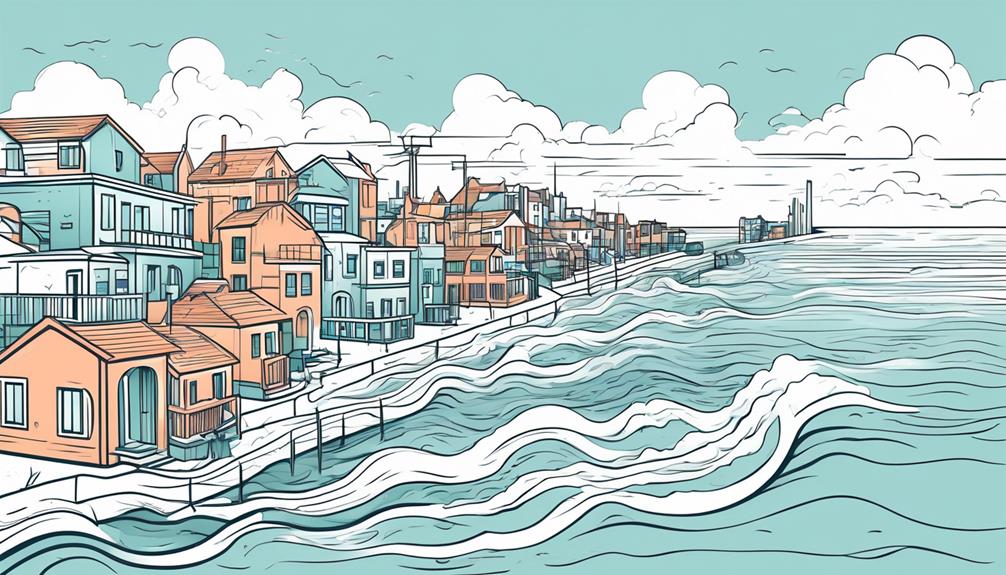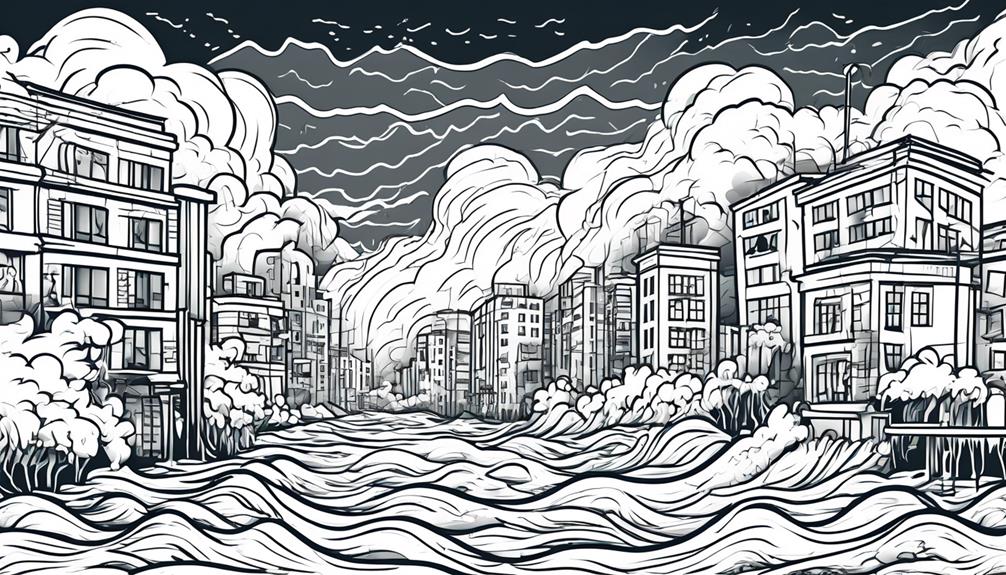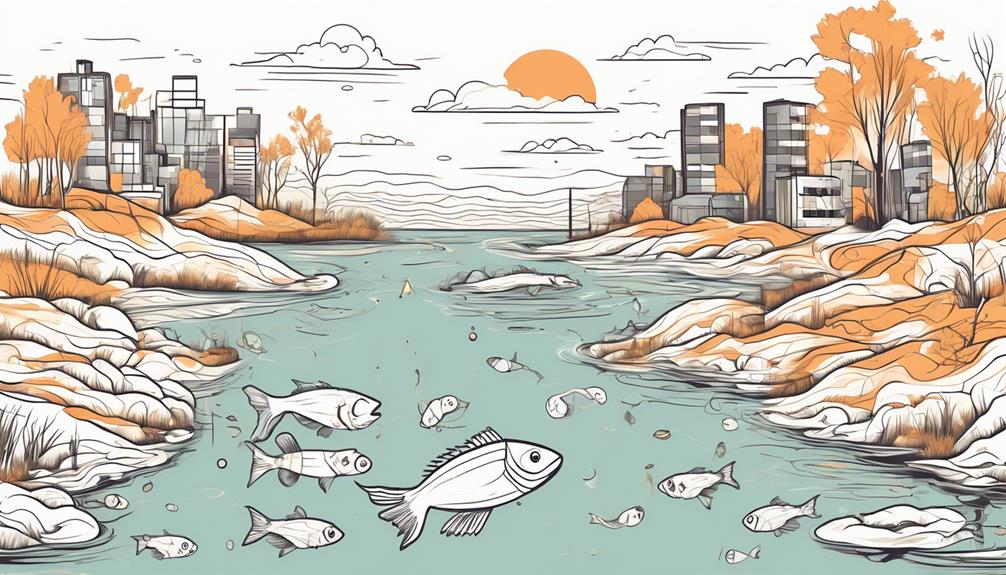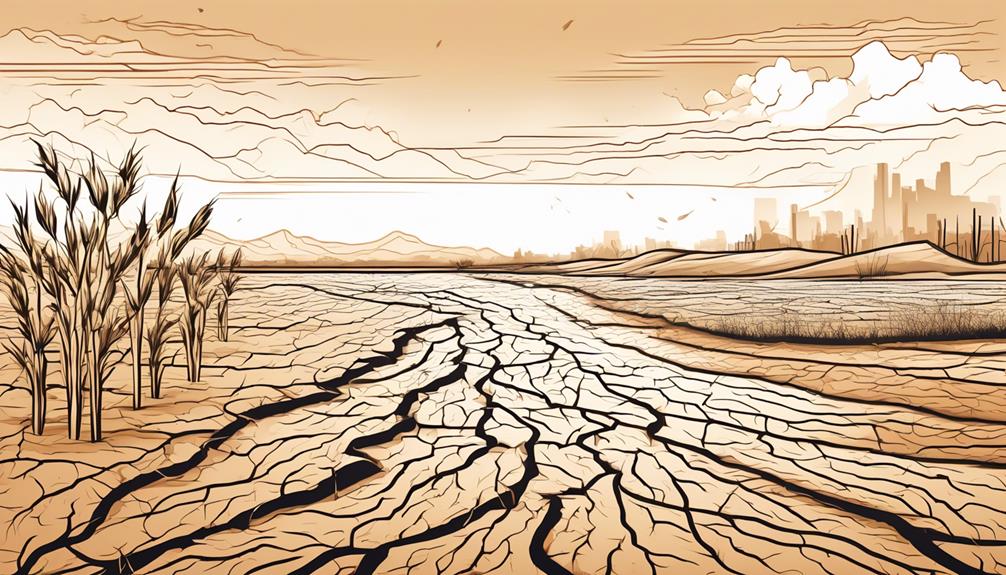Did you know that global warming not only affects the temperature of the Earth but also has a profound impact on our water supply? Changes in precipitation patterns, severe droughts, melting glaciers, rising sea levels – all these consequences of climate change are intricately linked to the water we rely on for our daily needs.
As you ponder over how these factors interplay with each other, you might be surprised by the ripple effect they have on various aspects of our lives.
Key Takeaways
- Changes in precipitation patterns are affecting both water quantity and quality, leading to challenges in securing water resources for agriculture and daily consumption.
- Ecosystems and biodiversity are experiencing significant impacts, such as altered food chains, loss of critical habitats, and disruptions in species distribution, due to climate change's effects on water availability.
- Risks of extreme weather events on water supply include contamination from floods, infrastructure damage, power outages, and increased contamination vulnerabilities during severe weather.
- Water contamination and quality degradation are worsening due to factors like heavy rains overwhelming sewage systems, algal blooms from higher temperatures, and glacial melting releasing pollutants, affecting drinking, cooking, and sanitation water availability.
Changes in Precipitation Patterns
Experiencing shifts in rainfall distribution can directly impact water availability and quality in your region. As global warming alters weather patterns, some areas may see an increase in intense rainfall events, leading to flooding and soil erosion. Conversely, other regions might experience prolonged dry spells, resulting in droughts and water scarcity. These changes can disrupt ecosystems, agriculture, and overall water management systems.
Imagine heavy downpours overwhelming drainage systems and contaminating water sources with pollutants, affecting not only drinking water but also agricultural irrigation. Picture cracked earth and withered crops during extended periods of little to no rainfall, putting stress on local farmers and wildlife alike. These shifts in precipitation patterns not only challenge the quantity of water available but also impact its quality, posing risks to public health and the environment.
It is crucial to adapt to these changing conditions by implementing sustainable water management practices and investing in infrastructure that can withstand the challenges posed by erratic rainfall distribution. By being proactive and resourceful, we can mitigate the effects of global warming on our water supply.
Droughts and Water Scarcity
Hey there!
Let's talk about droughts and water scarcity.
Droughts have a big impact on water supply, leading to decreased availability.
This can have serious effects on ecosystems.
Impact of Droughts
Global warming's impact on water supply is increasingly evident through the rise in occurrences of droughts, leading to significant water scarcity issues worldwide. Droughts affect water supply in various ways:
- Reduced Reservoir Levels: Lakes and reservoirs shrink, affecting water availability.
- Crop Failures: Agriculture suffers, impacting food production and availability.
- Wildfires: Dry conditions increase the risk of wildfires, threatening ecosystems.
- Economic Impact: Industries relying on water face challenges, affecting economies.
- Health Concerns: Water scarcity can lead to hygiene issues and health risks for communities.
Addressing these drought impacts is crucial to ensure sustainable water resources for the future.
Decreased Water Availability
With decreasing water availability due to droughts and water scarcity, communities face growing challenges in securing essential resources for their needs. As global warming intensifies, water sources diminish, leading to more frequent and severe drought conditions.
Rivers and lakes shrink, impacting agriculture, industry, and daily water consumption. Farmers struggle to irrigate crops, industries face production limitations, and households experience water rationing. Dry, cracked earth replaces once fertile land, and reservoirs reach dangerously low levels. The cycle of drought perpetuates water scarcity, affecting millions worldwide.
Urgent action is needed to implement sustainable water management practices, promote water conservation, and mitigate the impacts of climate change on water resources. Only through collective efforts can we ensure a more water-secure future for all.
Effects on Ecosystems
Droughts and water scarcity pose significant challenges to ecosystems, disrupting delicate balances and threatening biodiversity.
- Increased competition: Plants and animals fight for limited water resources, leading to stress and potential habitat loss.
- Altered food chains: Water scarcity affects the availability of prey, disrupting the food chain and impacting predator populations.
- Loss of wetlands: Critical wetland habitats dry up, endangering species that rely on these ecosystems for survival.
- Decreased water quality: Lower water levels concentrate pollutants, harming aquatic life and overall ecosystem health.
- Shifts in species distribution: Some species may move to new areas in search of water, causing changes in ecosystem dynamics.
Melting Glaciers and Ice Caps
As glaciers and ice caps around the world continue to melt at an alarming rate, the impact on water supply becomes increasingly evident. The melting of these massive ice formations directly affects the availability of freshwater resources, leading to potential water shortages in various regions.
| Effects of Melting Glaciers and Ice Caps |
|---|
| 1. Water Quality: Melting ice can introduce impurities and alter the chemical composition of water sources. |
| 2. Sea Level Rise: Meltwater contributes to rising sea levels, increasing the risk of coastal flooding. |
| 3. Hydropower: Changes in freshwater availability can impact hydropower generation, affecting energy supply. |
| 4. Ecosystem Disruption: Melting ice disrupts habitats for various species, leading to ecosystem imbalances. |
| 5. Water Scarcity: Reduced glacier and ice cap volume can exacerbate water scarcity issues in arid regions. |
Understanding the repercussions of melting glaciers and ice caps is crucial for implementing sustainable water resource management strategies and mitigating the effects of global warming on our water supply.
Sea-Level Rise and Saltwater Intrusion

Sea-level rise caused by melting glaciers and ice caps is leading to saltwater intrusion in coastal areas, impacting freshwater sources. This intrusion of saltwater into freshwater reservoirs is a significant consequence of climate change that directly affects communities and ecosystems.
Here's why this is crucial:
- Threat to Agricultural Lands: Saltwater intrusion can contaminate soil and reduce crop yields, posing a threat to agriculture.
- Risk to Drinking Water: The infiltration of saltwater into freshwater sources jeopardizes the availability of safe drinking water for coastal populations.
- Damage to Ecosystems: Saltwater intrusion disrupts the delicate balance of coastal ecosystems, endangering diverse plant and animal species.
- Increased Water Treatment Costs: Treating salt-contaminated water requires advanced technologies, increasing the cost of water supply management.
- Infrastructure Vulnerability: Saltwater intrusion corrodes infrastructure like pipes and pumps, necessitating costly repairs and replacements.
As sea levels continue to rise, addressing saltwater intrusion is paramount to ensuring water security for coastal regions.
Impact on Aquatic Ecosystems
With rising global temperatures, the impact on aquatic ecosystems becomes increasingly pronounced. Aquatic life is highly sensitive to even small changes in temperature and water quality. As temperatures rise, many species of fish, plants, and other organisms face challenges in adapting quickly enough to survive.
—
| Effects of Global Warming on Aquatic Ecosystems | Emotional Response |
|---|---|
| Loss of biodiversity due to habitat destruction | Sadness |
| Increase in harmful algal blooms | Concern |
| Disruption of food chains and ecosystems | Alarm |
—
These changes not only affect the aquatic creatures directly but also have ripple effects throughout the ecosystem. The emotional response evoked by the loss of biodiversity, increase in harmful algal blooms, and disruption of food chains highlights the urgency of addressing global warming to protect our aquatic ecosystems. It is crucial to take action now to mitigate these impacts and preserve the delicate balance of our water environments.
Extreme Weather Events

When extreme weather strikes due to global warming, you face harsh realities. Droughts and floods disrupt water availability, while risks of contamination increase.
The structures that supply your water may also become vulnerable to the impacts of these events.
Droughts and Floods
During periods of extreme weather events such as droughts and floods, the impact of global warming on water supply becomes glaringly evident.
- Droughts:
- Decrease water availability for drinking, irrigation, and industries.
- Floods:
- Contaminate water sources with pollutants and debris.
- Soil Erosion:
- Increases due to intense rainfall, leading to sedimentation of water bodies.
- Water Scarcity:
- Exacerbates as droughts become more frequent and prolonged.
- Infrastructure Damage:
- Water treatment plants and distribution systems are compromised during floods, disrupting water supply.
Global warming intensifies these extreme events, making it crucial to implement sustainable water management strategies to ensure water security for future generations.
Water Contamination Risks
Global warming's impact on water supply through droughts and floods highlights the heightened risks of water contamination during extreme weather events. When heavy rains pour, they can overwhelm sewage systems, causing untreated waste to flow into water sources. Floodwaters can carry harmful chemicals and bacteria from various sources, polluting drinking water reservoirs.
On the other hand, droughts reduce water levels, concentrating pollutants and increasing their potency. Pesticides, fertilizers, and industrial waste become more concentrated in less water, intensifying the risk of contamination. Additionally, higher temperatures can lead to algal blooms, further contaminating water supplies.
These factors combined pose significant challenges to ensuring clean and safe drinking water during extreme weather events impacted by global warming.
Infrastructure Vulnerabilities
Experiencing extreme weather events can expose vulnerabilities in water supply infrastructure, risking contamination and safety concerns. During such events, the following issues may arise:
- Flood Damage: Heavy rainfall can overwhelm treatment plants, leading to untreated water entering the supply.
- Pipeline Breaks: Intense storms or flooding can cause pipelines to rupture, disrupting water distribution.
- Power Outages: Severe weather often results in power failures, impacting water treatment processes.
- Infrastructure Stress: Extreme temperatures can strain infrastructure, potentially causing leaks or failures.
- Debris Blockages: Storms can carry debris that clogs water intakes, affecting the water flow.
These vulnerabilities highlight the urgent need for resilient infrastructure to safeguard our water supply in the face of climate change.
Water Quality Degradation

As our planet warms, the quality of our water is deteriorating rapidly. Picture this: warmer temperatures lead to increased levels of toxins like algae in water sources. These toxins not only make water unsafe for consumption but also harm aquatic life. Moreover, rising temperatures can cause changes in water pH levels, impacting the balance of ecosystems.
Imagine a beautiful lake you used to swim in during the summer. Now, due to poor water quality from global warming, that same lake may be filled with harmful bacteria, making it unsafe for swimming. The impact extends beyond just recreation; it affects the availability of clean water for drinking, cooking, and sanitation.
Additionally, as glaciers melt faster due to higher temperatures, they release pollutants that have been trapped for years. These pollutants find their way into rivers and lakes, further contaminating our water supply.
In essence, the degradation of water quality due to global warming is a critical issue that requires immediate attention to safeguard our health and the environment.
Disruption of Water Infrastructure
You know those old pipes underground? Well, with global warming, they're becoming more vulnerable to leaks and breaks.
Plus, with the rising sea levels and increased flooding risks, our water infrastructure is facing some serious challenges ahead.
It's like a puzzle that needs solving before we run out of clean water to drink.
Aging Pipes Vulnerability
Aging pipes in water systems across the globe are at risk of failure due to the impacts of global warming, threatening the stability of water infrastructure. This vulnerability stems from various factors:
- Corrosion: Increased temperatures accelerate the corrosion of pipes.
- Bursting: Extreme weather events lead to sudden pressure changes, causing pipes to burst.
- Leakage: Higher temperatures can weaken joints, resulting in water leaks.
- Decreased Capacity: Sediment buildup from changing water patterns reduces pipe capacity.
- Water Contamination: Heat can cause chemical reactions in pipes, contaminating water.
These issues highlight the urgent need to address aging infrastructure to ensure a reliable water supply in the face of climate change.
Increased Flooding Risks
Faced with the looming threat of increased flooding, water infrastructure stands vulnerable to significant disruptions caused by the escalating impacts of global warming. As heavy rainfall and rising sea levels become more frequent, the risk of floods damaging vital water facilities like treatment plants and distribution systems increases.
Imagine torrential downpours overwhelming drainage systems, leading to sewage overflows contaminating clean water supplies. Picture rivers swelling beyond their banks, submerging pump stations and wells essential for providing safe drinking water.
The aftermath of such events includes service outages, water contamination, and costly repairs. Addressing these flooding risks through improved infrastructure planning and adaptation measures is crucial to safeguarding our water supply for the future.
Effects on Agriculture and Food Security

Rising global temperatures due to climate change are increasingly impacting agriculture and food security worldwide. This has led to significant challenges for farmers and food production systems. Here's how this is affecting agriculture and food security:
- Crop Failures: High temperatures and changing precipitation patterns are causing crop failures, leading to food shortages and price hikes.
- Water Scarcity: Droughts are becoming more frequent, reducing water availability for irrigation and livestock, affecting crop yields.
- Pests and Diseases: Warmer temperatures create favorable conditions for pests and diseases, damaging crops and reducing harvests.
- Shifts in Growing Seasons: Changing weather patterns are disrupting traditional growing seasons, affecting planting and harvesting times.
- Loss of Biodiversity: Climate change is altering ecosystems, leading to a loss of biodiversity crucial for resilient agriculture and food production.
These impacts highlight the urgent need for sustainable farming practices and climate-resilient food systems to ensure food security in the face of global warming.
Public Health Risks and Challenges
With global warming intensifying, the public health sector is encountering a myriad of risks and challenges that demand immediate attention and action. The table below outlines some of the key public health risks associated with global warming:
| Risk Type | Description | Impact |
|---|---|---|
| Heat-related Illnesses | Increased frequency and intensity of heatwaves leading to heat exhaustion and heatstroke. | Higher hospital admissions and mortality rates. |
| Vector-borne Diseases | Expansion of habitats for disease-carrying insects like mosquitoes, increasing the spread of diseases such as malaria and dengue fever. | Surge in cases of vector-borne illnesses. |
| Waterborne Diseases | Rising temperatures affecting water quality, leading to an increase in waterborne diseases like cholera and typhoid. | Higher rates of gastrointestinal illnesses. |
| Respiratory Issues | Poor air quality due to increased wildfires and pollen production exacerbating respiratory conditions like asthma and allergies. | More respiratory-related hospital visits and complications. |
| Food Insecurity | Disruption in food production and distribution due to extreme weather events impacting food availability and nutrition. | Higher risk of malnutrition and related health problems. |
Frequently Asked Questions
How Does Global Warming Impact the Availability of Groundwater Resources?
Global warming can lead to less groundwater availability as rising temperatures cause faster evaporation, reducing water levels. This affects your access to clean water for drinking and agriculture. It's vital to address this issue to protect our water supply.
What Are the Potential Long-Term Consequences of Increased Water Temperature on Aquatic Life?
Imagine warmer waters suffocating aquatic life, disrupting ecosystems, and causing mass die-offs. As temperatures rise, oxygen levels decrease, harming fish and other creatures. Long-term consequences include imbalanced food chains, biodiversity loss, and ecosystem collapse.
How Does Global Warming Contribute to the Spread of Waterborne Diseases?
When global warming heats up the Earth, it creates an ideal environment for waterborne diseases to thrive. As temperatures rise, harmful pathogens in water sources multiply, increasing the risk of spreading illnesses to those who come in contact.
Are There Any Solutions or Strategies Being Implemented to Mitigate the Effects of Global Warming on Water Supply?
Like a gardener tending to delicate blooms, efforts to mitigate global warming's impact on water supply are increasing. Innovative strategies like water conservation, sustainable agriculture, and green infrastructure are being implemented to safeguard this vital resource.
How Does Global Warming Affect the Distribution and Accessibility of Drinking Water in Urban Versus Rural Areas?
In urban areas, global warming can strain water systems, leading to scarcity. Rural regions face challenges due to altered rainfall patterns, affecting water sources. Both areas need innovative solutions to ensure clean and accessible drinking water for all.
Conclusion
As global warming continues to affect our water supply, it's like a delicate web being slowly unraveled. Changes in precipitation patterns, droughts, melting glaciers, and rising sea levels are just a few threads in this intricate tapestry.
The impact on aquatic ecosystems, water quality, agriculture, and public health is undeniable. Our water resources are like a precious gem, slowly losing its shine.
It's time to take action before this invaluable resource slips through our fingers.